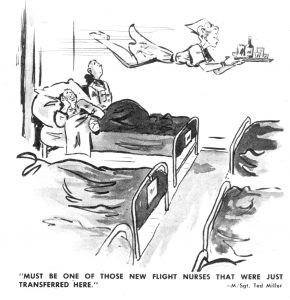Meet the former US Army flight nurses whom I interviewed for
Beyond the Call of Duty: Army Flight Nursing in World War II.
In 1986 as part of my research about flight nurse history and coping with war, I was privileged to interview 25 former US Army nurses about events of their flight nurse duty in World War II. Most of them are now deceased, but their stories live on in Beyond the Call of Duty: Army Flight Nursing in World War II.
The journal I kept of my time with each of them in 1986 when writing my dissertation offers a brief personal glimpse of these remarkable women. I am sharing edited versions of these journals, in the order in which the interviews took place. The actual interviews are in separate documents.
11th Interview
Dorothy Vancil Morgan
805 MAES Flight C Central Africa, US
15 May 1986
I interviewed Dorothy Morgan in her home in San Antonio, Texas. She had procrastinated writing me, she said, because she didn’t know if she fit the criteria for my study. While she had been stationed overseas in Central Africa as a flight nurse during World War II, she was not actually in a combat zone. Rather than flying into other areas to pick up patients, the patients were brought to her on one of several legs of a trip that eventually flew patients from the China-Burma-India Theater to Africa, on to Natal, Brazil, and finally to Miami, Florida. Dorothy had decided that perhaps I didn’t want to hear from someone who actually had had fun during her flying assignment and whose training was far more rugged than her actual flight nurse assignment. One of the things that won her over and led her to respond to my letter, Dorothy said, was that I had included a self-addressed envelope and even had put a stamp on it.
Dorothy requested that I ask her questions rather than simply having her talk about her experiences. I complied, but I was pleased that she also contributed much information spontaneously. Her experiences were unique in that she was a member of a flight of six nurses —Flight C of the 805 MAES—assigned to the Central African Wing. Flights A and B of the 805th were assigned to the Alaskan Wing. Dorothy also flew one year of wartime flight nurse duty stateside, and it was in her stateside assignment that she encountered the most serious battle casualties of the war. Most of the patients she evacuated while overseas were ambulatory. She had gone to Africa with thoughts about how she would be another Florence Nightingale, Dorothy said, but found that much of her work was simply to be friendly and boost her patients’ spirits. Cheery words, songs, and a pat on the back “did them more good than all the morphine in the world.”
While Dorothy had some trouble remembering various details from her actual air evacuation duty both overseas and stateside, she did contribute interesting data concerning what it was like to be a flight nurse during World War II in two areas of assignment not yet mentioned in my interviews. Toward the end of the interview, Dorothy said of the flight nurses of whom she was a part, “But we’re all kind of hiding our glories in a book, or something like that. Our medals and whatnot are in a drawer back there. But at the time that we were in, it was not for the glory, you know. It was because it was a need, and we wanted to help out.”
One of Dorothy’s stories: Dorothy had a close call on a stateside mission when she and her medical technician were flying with 21 patients from New York. Both motors on the C-47 stopped, and the pilot had to make an emergency landing on a narrow grass airstrip between two hills, with final approach over water. They touched down safely, and Dorothy immediately contacted the local civilian hospital, whose staff made arrangements to accommodate the patients. Both she and the patients were treated royally. “They should have sold bonds,” she said, because the people of that little town turned out in full force. The patients continued their journey safely by ground transportation the next morning when an ambulance convoy with police escort and staff car arrived to take them to the nearest military base about 50 miles away. The town had never seen so much to-do, Dorothy laughed. “But it was quite a deal! It was!”
Dorothy died in 2000.



